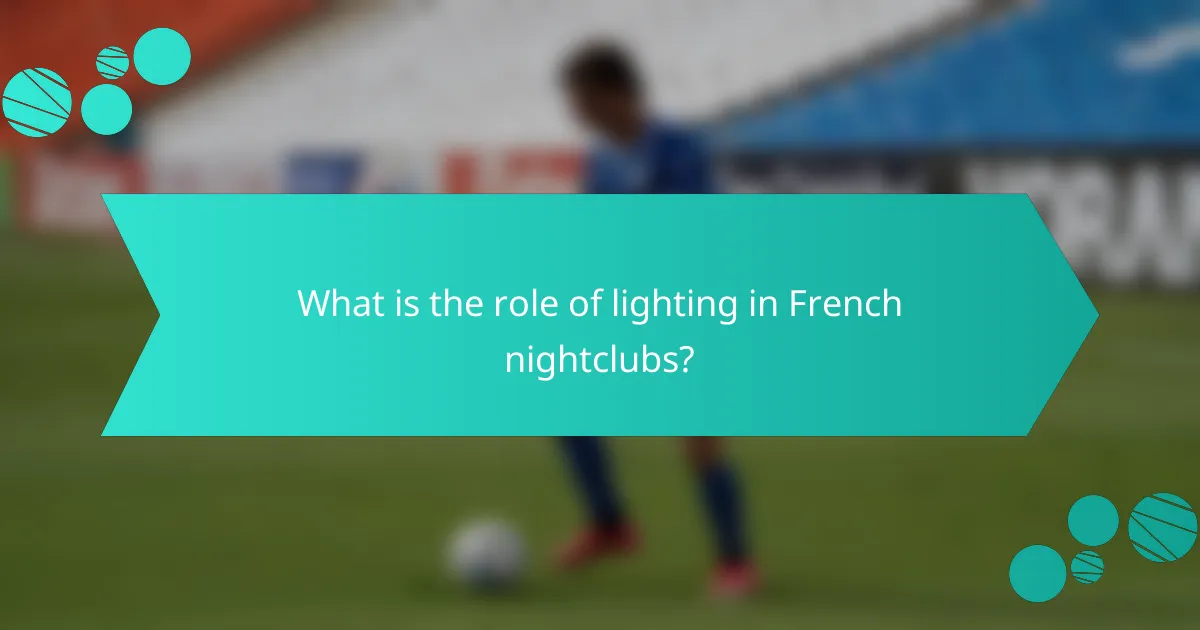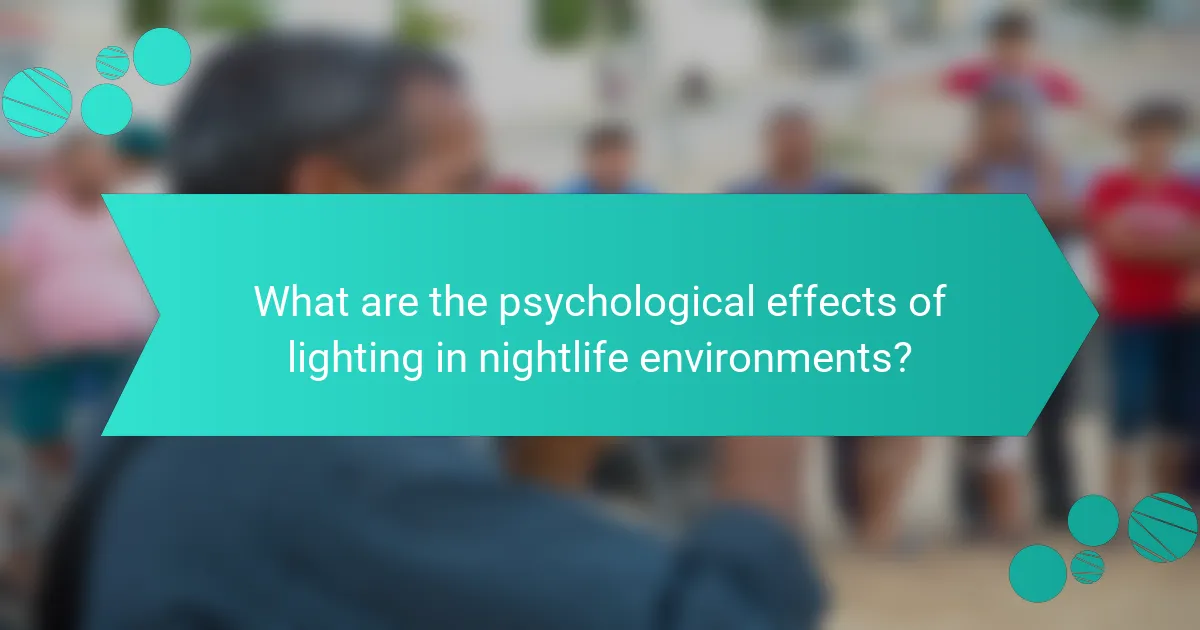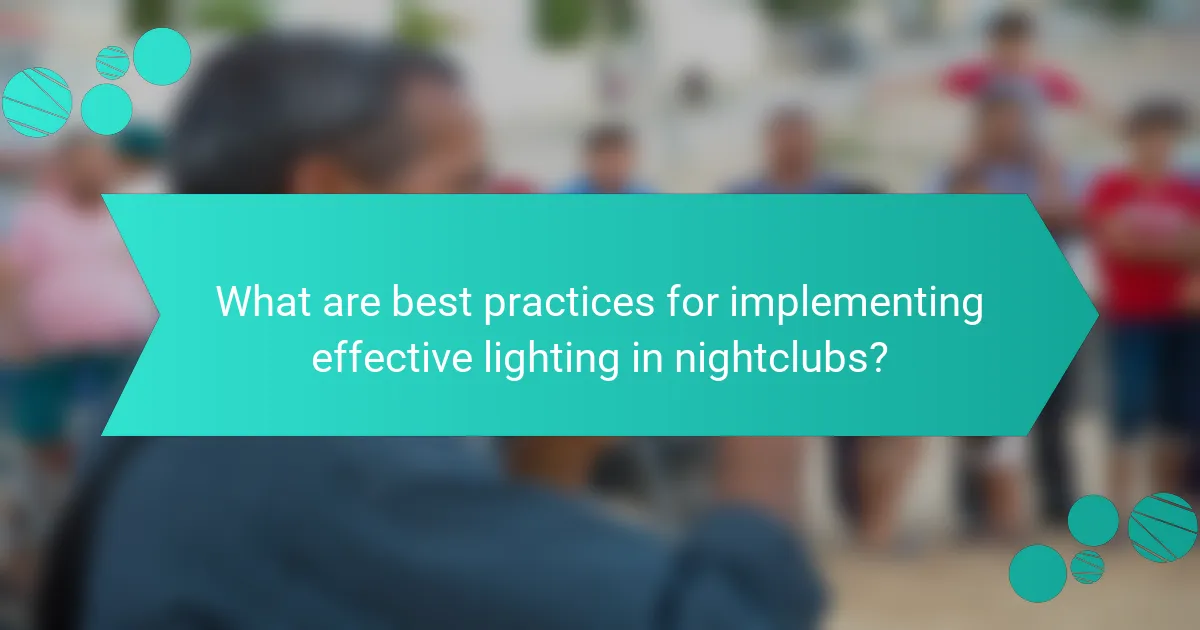Lighting in French nightclubs is a critical element that shapes the atmosphere and influences the mood and energy levels of guests. Dynamic lighting, including color-changing LEDs and synchronized effects with music, enhances the overall nightlife experience by evoking specific emotions and promoting social interactions. Research indicates that well-designed lighting can improve guest satisfaction and encourage longer stays. The article explores the psychological effects of different lighting conditions, emphasizing the importance of effective lighting design in creating engaging and immersive environments for nightclub patrons. Key aspects include the use of brightness, color temperature, and strategic positioning to optimize the nightlife experience.

What is the role of lighting in French nightclubs?
Lighting in French nightclubs plays a crucial role in shaping the atmosphere. It influences the mood and energy levels of guests. Dynamic lighting can enhance the overall experience by creating an immersive environment. Different colors and intensities can evoke specific emotions, such as excitement or relaxation. Additionally, synchronized lighting with music can elevate the dance experience. Studies show that well-designed lighting can increase guest satisfaction and encourage longer stays. Ultimately, effective lighting design is essential for a vibrant nightlife experience in French clubs.
How does lighting influence mood in nightclub settings?
Lighting significantly influences mood in nightclub settings. It affects how patrons feel and interact with their environment. Bright, dynamic lighting can create excitement and energy. Dimming lights often promote intimacy and relaxation. Color choices also play a crucial role; warm tones can evoke comfort, while cool tones may enhance alertness. Studies show that lighting conditions can alter perceptions of time and space in social settings. For instance, a study published in the Journal of Environmental Psychology found that dim lighting can lead to longer stays and increased spending. Hence, effective lighting design is essential for enhancing guest experiences in nightclubs.
What types of lighting are commonly used in French nightclubs?
French nightclubs commonly use LED lighting, strobe lights, and laser lights. LED lighting provides vibrant colors and energy efficiency. Strobe lights create dynamic visual effects that enhance the dance experience. Laser lights produce sharp beams that can create intricate patterns. Additionally, ambient lighting sets the mood and complements the overall atmosphere. These lighting types are essential for creating an engaging and immersive environment for guests.
How do different colors of lighting affect guest emotions?
Different colors of lighting significantly affect guest emotions. Warm colors, such as red and orange, tend to evoke feelings of warmth, comfort, and excitement. Studies show that these colors can increase heart rates and stimulate energy levels. Cool colors, like blue and green, promote calmness and relaxation. Research indicates that blue lighting can lower anxiety levels and create a soothing atmosphere. Yellow lighting is associated with happiness and optimism, enhancing social interactions among guests. Each color’s psychological impact is supported by studies in environmental psychology, confirming that lighting influences mood and behavior in social settings.
What impact does lighting have on energy levels in nightclubs?
Lighting significantly impacts energy levels in nightclubs. Bright and dynamic lighting can enhance excitement and stimulate movement among guests. Conversely, dim lighting often leads to a more relaxed atmosphere, reducing energy levels. Studies indicate that colorful and flashing lights can elevate mood and increase the desire to dance. Research shows that environments with synchronized lighting to music create a more immersive experience. This heightened engagement can lead to longer stays and increased spending. Overall, the type and intensity of lighting directly correlate with guests’ energy and enjoyment levels in nightclubs.
How does dynamic lighting create a lively atmosphere?
Dynamic lighting creates a lively atmosphere by adjusting brightness and color in real-time. This adaptability stimulates visual interest and enhances emotional responses. Studies show that dynamic lighting can increase energy levels and engagement among guests. For example, a 2019 study published in the Journal of Environmental Psychology found that changing light colors can elevate mood and excitement. Furthermore, dynamic lighting can synchronize with music, creating a multisensory experience. This synchronization reinforces the rhythm and encourages movement, making guests more likely to dance and socialize. Overall, the interaction between light and sound fosters a vibrant nightlife experience.
What is the relationship between lighting intensity and guest activity?
Lighting intensity directly influences guest activity levels in nightclubs. Higher lighting intensity often correlates with increased energy and engagement among guests. Studies show that brighter environments can stimulate social interactions and encourage movement. In contrast, dim lighting tends to create a more relaxed atmosphere, leading to subdued activity. Research indicates that guests are more likely to dance and socialize in well-lit areas. A study by Spence et al. (2014) found that lighting affects mood and behavior, impacting how guests interact. Therefore, adjusting lighting intensity can strategically enhance the overall nightclub experience.
How does lighting enhance the overall guest experience in nightclubs?
Lighting enhances the overall guest experience in nightclubs by creating an immersive atmosphere. Effective lighting design influences mood and energy levels. It can evoke emotions, making guests feel excited or relaxed. Dynamic light displays sync with music, enhancing the overall enjoyment. Studies show that well-lit environments can increase social interaction among guests. Research indicates that lighting impacts the perception of space, making areas feel larger or more intimate. A survey by the Nighttime Economy Advisory Group found that 75% of club-goers prefer venues with engaging lighting. This suggests that lighting plays a crucial role in attracting and retaining guests.
What role does lighting play in creating a memorable ambiance?
Lighting is crucial in creating a memorable ambiance. It influences mood, energy levels, and overall guest experience. Different lighting styles evoke various emotions. For instance, dim lighting can create intimacy, while bright lights energize and stimulate activity. Color temperature also affects perception; warm tones are often associated with comfort, whereas cool tones can feel more vibrant. Studies show that well-designed lighting can enhance social interactions and increase dwell time. In French nightclubs, strategic lighting design is essential to maintain an engaging atmosphere. Effective lighting can transform a space, making it more inviting and memorable for guests.
How can lighting design influence social interactions among guests?
Lighting design significantly influences social interactions among guests. It affects mood, energy levels, and the overall atmosphere. For instance, warm lighting can create an inviting environment that encourages conversation. In contrast, harsh lighting may lead to discomfort and inhibit social engagement. Research indicates that dim lighting fosters intimacy, promoting closer connections among guests. A study by the University of Southern California found that softer lighting increases the likelihood of social bonding. Additionally, dynamic lighting can energize spaces, encouraging movement and interaction. This interplay of light can shape guest experiences in nightclubs, ultimately affecting their social behavior.

What are the psychological effects of lighting in nightlife environments?
Lighting in nightlife environments significantly influences psychological states. It affects mood, energy levels, and social interactions. Bright lighting can enhance alertness and excitement. Dim lighting often promotes relaxation and intimacy. Color temperature also plays a crucial role. Warm colors can evoke feelings of comfort and warmth. Conversely, cool colors may stimulate energy and alertness. Research indicates that lighting impacts behavior and emotional responses. For example, a study by Küller et al. (2006) found that different lighting conditions can alter mood and perceived comfort in social settings. Thus, lighting design in nightlife venues is essential for shaping guest experiences.
Why is understanding lighting psychology important for nightclub owners?
Understanding lighting psychology is crucial for nightclub owners because it directly impacts guest experience and behavior. Proper lighting can enhance mood and energy levels, encouraging guests to stay longer and spend more. Studies show that specific colors and intensities of light can evoke different emotional responses. For instance, warm lights create a cozy atmosphere, while bright, dynamic lights can energize the crowd. Effective lighting design can also influence social interactions, making spaces feel more inviting. According to research published in the Journal of Environmental Psychology, lighting significantly affects how people perceive a space and their overall enjoyment. This understanding allows nightclub owners to create environments that align with their brand and attract desired clientele.
How can lighting choices affect guest retention and satisfaction?
Lighting choices significantly affect guest retention and satisfaction in nightclubs. Well-designed lighting creates an inviting atmosphere. It enhances the mood and energy levels of guests. Research shows that appropriate lighting can increase the length of stay. A study by the University of Southern California found that vibrant lighting can boost customer satisfaction by 20%. Guests are more likely to return to venues that provide a visually stimulating experience. Conversely, poor lighting can lead to discomfort and dissatisfaction. This can decrease the likelihood of repeat visits. Overall, effective lighting is crucial for maximizing guest retention and satisfaction in nightclubs.
What psychological principles are at play in lighting design?
Lighting design incorporates several psychological principles that influence human behavior and emotions. One key principle is color psychology, where different colors evoke specific feelings. For instance, warm colors like red and orange can stimulate energy and excitement. In contrast, cool colors such as blue and green promote calmness and relaxation.
Another principle is the concept of brightness and its effect on mood. Brighter environments can enhance alertness and engagement. Dim lighting can create a sense of intimacy and relaxation.
The principle of spatial perception also plays a role. Lighting can alter the perception of space, making areas feel larger or cozier. This impacts how individuals navigate and interact within a space.
Finally, the principle of contrast affects visual interest and focus. High contrast lighting can draw attention to specific areas or elements, enhancing the overall experience.
Research supports these principles, indicating that lighting significantly impacts mood and behavior in social settings. For example, a study published in the Journal of Environmental Psychology found that lighting affects emotional responses and social interactions.
How do cultural factors influence lighting preferences in French nightclubs?
Cultural factors significantly influence lighting preferences in French nightclubs. The French prioritize aesthetics and ambiance in social settings. This emphasis shapes the use of dim, warm lighting to create an intimate atmosphere. Additionally, cultural events and local traditions dictate specific lighting styles. For instance, during celebrations, vibrant colors and dynamic lighting enhance the festive mood. Research indicates that French nightlife often incorporates artistic lighting designs. These designs reflect the country’s rich cultural heritage and artistic sensibilities. Ultimately, the interplay of cultural values and lighting choices shapes the overall nightclub experience in France.
What are the typical lighting trends in French nightlife culture?
French nightlife culture typically features dynamic lighting trends. These trends often include the use of LED lights, strobe effects, and color-changing systems. Nightclubs frequently employ low ambient lighting to create an intimate atmosphere. Additionally, spotlights are used to highlight performers and DJs. Laser displays are also common, adding visual excitement to the environment. The interplay of light and dark is essential for enhancing energy levels. Research indicates that effective lighting can significantly influence guest mood and overall experience. Studies show that vibrant colors can elevate emotions and encourage social interaction among patrons.
How does local music influence lighting choices in nightclubs?
Local music significantly influences lighting choices in nightclubs. Nightclubs often adjust lighting to match the rhythm and style of the local music being played. For example, vibrant colors and dynamic patterns may be used to enhance energetic genres like electronic dance music. Conversely, softer lighting may accompany more mellow genres, creating a relaxed atmosphere. Research shows that lighting can affect mood and energy levels, aligning with the tempo of the music. This synchronization enhances the overall guest experience, making the environment feel cohesive. Studies indicate that effective lighting design can elevate the emotional impact of music, leading to longer stays and increased satisfaction among patrons.

What are best practices for implementing effective lighting in nightclubs?
Effective lighting in nightclubs should create an engaging atmosphere. Use a combination of dynamic and static lights to enhance mood. Incorporate color-changing LEDs to match the music tempo. Position lights to avoid glare and create comfortable visibility. Utilize spotlights to highlight performers or specific areas. Implement dimmers to adjust light intensity throughout the night. Consider the use of strobe lights for high-energy moments, but use them sparingly. According to a study by the Journal of Environmental Psychology, lighting significantly impacts guest enjoyment and energy levels in nightlife settings.
What key elements should be considered when designing nightclub lighting?
Key elements to consider when designing nightclub lighting include functionality, ambiance, and safety. Functionality involves ensuring that lighting enhances visibility for staff and guests. Ambiance is crucial for creating the desired mood, often achieved through color temperature and intensity. Safety must be prioritized with adequate lighting for exits and pathways. Additionally, lighting should be adaptable to different events and music styles. The use of dynamic lighting can enhance guest experience by syncing with music. Research shows that proper lighting positively impacts mood and energy levels, making it essential for a vibrant nightclub atmosphere.
How can technology enhance the lighting experience in nightclubs?
Technology can enhance the lighting experience in nightclubs through advanced lighting systems. These systems utilize LED and laser technologies to create dynamic visual effects. Programmable lighting allows synchronization with music, enhancing the overall atmosphere. Intelligent lighting systems can adjust colors and intensity based on crowd energy levels. This adaptability contributes to a more immersive experience for guests. Studies show that effective lighting can increase patron engagement and satisfaction. For instance, a study by the Journal of Environmental Psychology found that well-designed lighting can enhance mood and energy levels in social settings. This integration of technology ultimately elevates the nightclub experience for attendees.
What are common mistakes to avoid in nightclub lighting design?
Common mistakes to avoid in nightclub lighting design include poor light placement, inadequate brightness, and lack of color variety. Poor light placement can lead to uneven lighting, creating dark spots and shadows. Inadequate brightness may fail to energize the space, making it less inviting. A lack of color variety can result in a monotonous atmosphere that fails to engage guests. Additionally, ignoring the venue’s layout can hinder the overall experience. Failing to consider the type of events held can also lead to inappropriate lighting choices. Lastly, neglecting maintenance can result in malfunctioning lights, diminishing the ambiance. These mistakes can significantly impact guest experience and energy levels.
How can nightclub owners optimize lighting for different events?
Nightclub owners can optimize lighting for different events by tailoring the intensity, color, and movement of lights. For energetic events like dance parties, bright and dynamic lighting can enhance excitement. Utilizing strobe lights and vibrant colors can elevate the atmosphere. For more subdued events, such as lounge nights, softer, warmer lights create a relaxing environment. Dimmed lighting with subtle color changes can encourage conversation and comfort.
Implementing programmable lighting systems allows for quick adjustments based on the event type. Research shows that lighting significantly influences mood and energy levels. A study published in the Journal of Environmental Psychology indicates that different lighting conditions can affect patrons’ emotional responses. By understanding these principles, nightclub owners can enhance guest experiences effectively.
What strategies can be used to adapt lighting for themed nights?
Use color filters to match the theme of the night. For example, red for a romantic theme or blue for a chill vibe. Adjust brightness levels to create different atmospheres. Dim lights can promote intimacy, while bright lights can energize the space. Incorporate dynamic lighting effects, such as strobe lights or moving heads, to enhance excitement. Utilize themed props, like lanterns or neon signs, to complement the lighting design. Sync lighting changes with music beats to create a cohesive experience. Research shows that lighting significantly affects mood and energy levels, enhancing guest engagement.
How can feedback from guests inform lighting adjustments?
Feedback from guests can inform lighting adjustments by providing insights into their preferences and experiences. Guests may express their feelings about brightness, color schemes, and overall ambiance. This feedback helps nightclub managers understand which lighting setups enhance enjoyment and which may detract from the experience. For example, if multiple guests report that lighting is too dim, adjustments can be made to improve visibility and comfort. Conversely, if guests appreciate certain lighting effects during specific events, those can be incorporated more frequently. Analyzing guest feedback allows for data-driven decisions, ensuring lighting aligns with guest expectations and enhances the overall atmosphere.
The main entity of the article is lighting in French nightclubs, which significantly influences mood, energy levels, and overall guest experience. The article explores how different types of lighting, including LED, strobe, and laser lights, create immersive environments that enhance excitement and social interactions. It examines the psychological effects of various colors and intensities of light on patrons, highlighting the importance of effective lighting design for guest retention and satisfaction. Additionally, the article discusses best practices for implementing lighting strategies tailored to different events and themes, underscoring the role of technology and guest feedback in optimizing nightclub lighting.